In the not-so-distant past, education operated on a one-size-fits-all model, limiting the ability to cater to individual learning needs. Enter machine learning, a groundbreaking technology that has gone beyond the confines of science fiction.
The concept of machine learning in education is not a new idea brought on by the rise of ChatGPT and the like – it’s a developing approach as seen in the growing increase in publications on AI and ML in education since 2010. This has led to the development of new educational tools and software, fundamentally changing how we learn and teach.
In this article, we will explore the benefits of machine learning in education and share some exciting machine learning examples and applications in the education sector that are already making a significant impact.
Understanding Machine Learning in Education
What is Machine Learning?
At its core, machine learning is a branch of AI that involves the development of algorithms, enabling computers to learn from data and make predictions or decisions without human intervention. This learning process is iterative, allowing the system to continuously refine its understanding and adapt to new information.
Machine learning in education specifically refers to the application of these machine learning algorithms to enhance the teaching and learning experience. By leveraging data on student performance, preferences, and learning styles, machine learning can personalize learning paths, predict areas where students might struggle, and provide educators with valuable insights to improve their instruction.
Learn how to use AI to your advantage in the classroom with this comprehensive guide on the A-Z of AI in education.
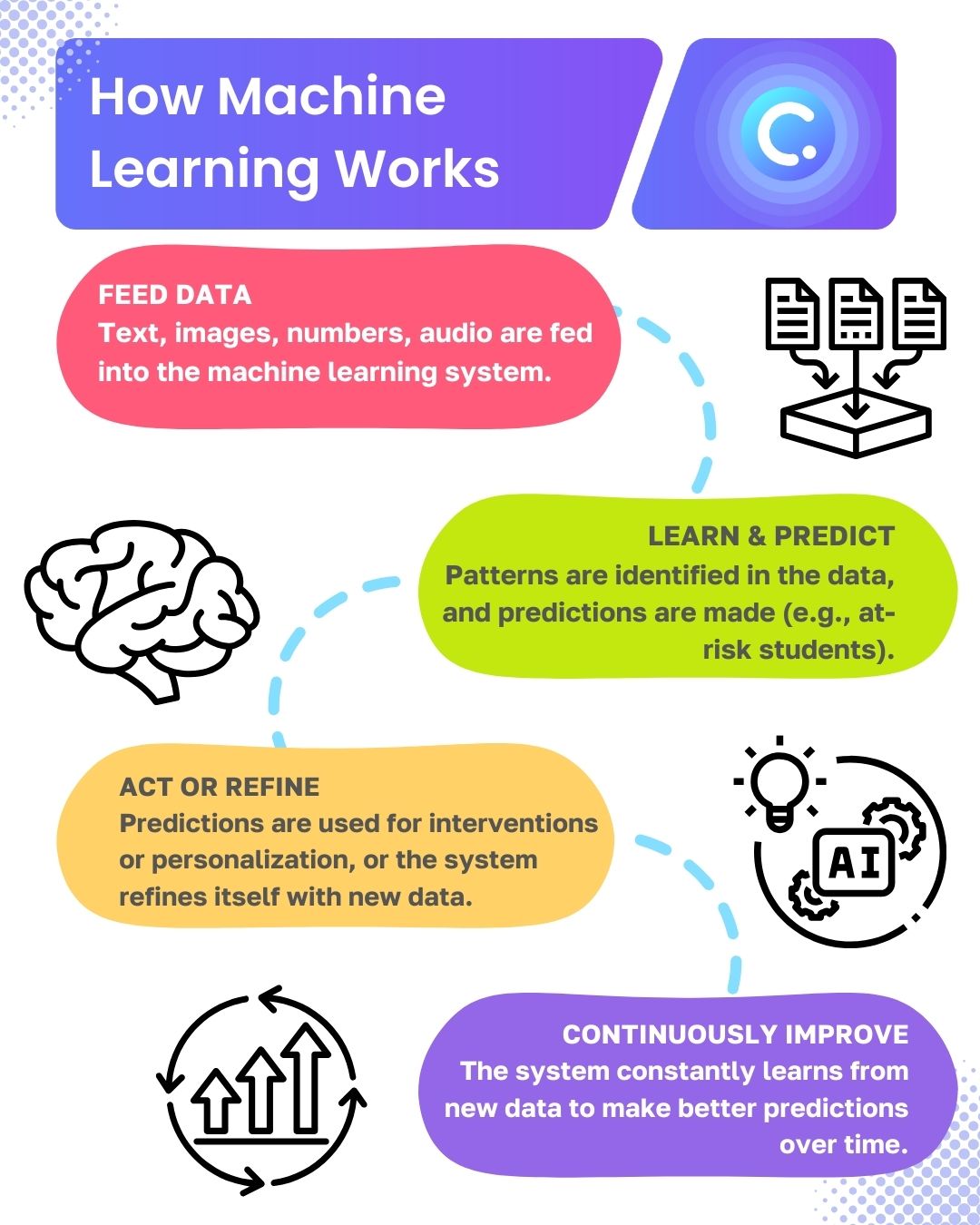
Using Data as Fuel
Machine learning algorithms are highly data-driven. They thrive on massive datasets, which can be anything from text and images to numbers and audio recordings. As the algorithm processes this data, it starts to recognize patterns and relationships within the information.
Generating Predictions
After learning from a mountain of inputted data, the algorithm can use this knowledge to make smart guesses about new information. In education, this translates to predicting at-risk students or tailoring learning materials based on a student’s individual strengths and weaknesses.
Continuous Improvement
When the algorithm encounters new data points, it analyzes these new inputs, refines its internal model, and strengthens its ability to identify patterns and relationships. This continuous improvement allows the machine learning system to adapt to new information and become more precise in its predictions over time.
Machine learning in education introduces adaptability and personalization into the educational journey. It challenges the limitations of one-size-fits-all education by tailoring content delivery to individual learning styles and adjusting to student progress
Benefits of Machine Learning in Education
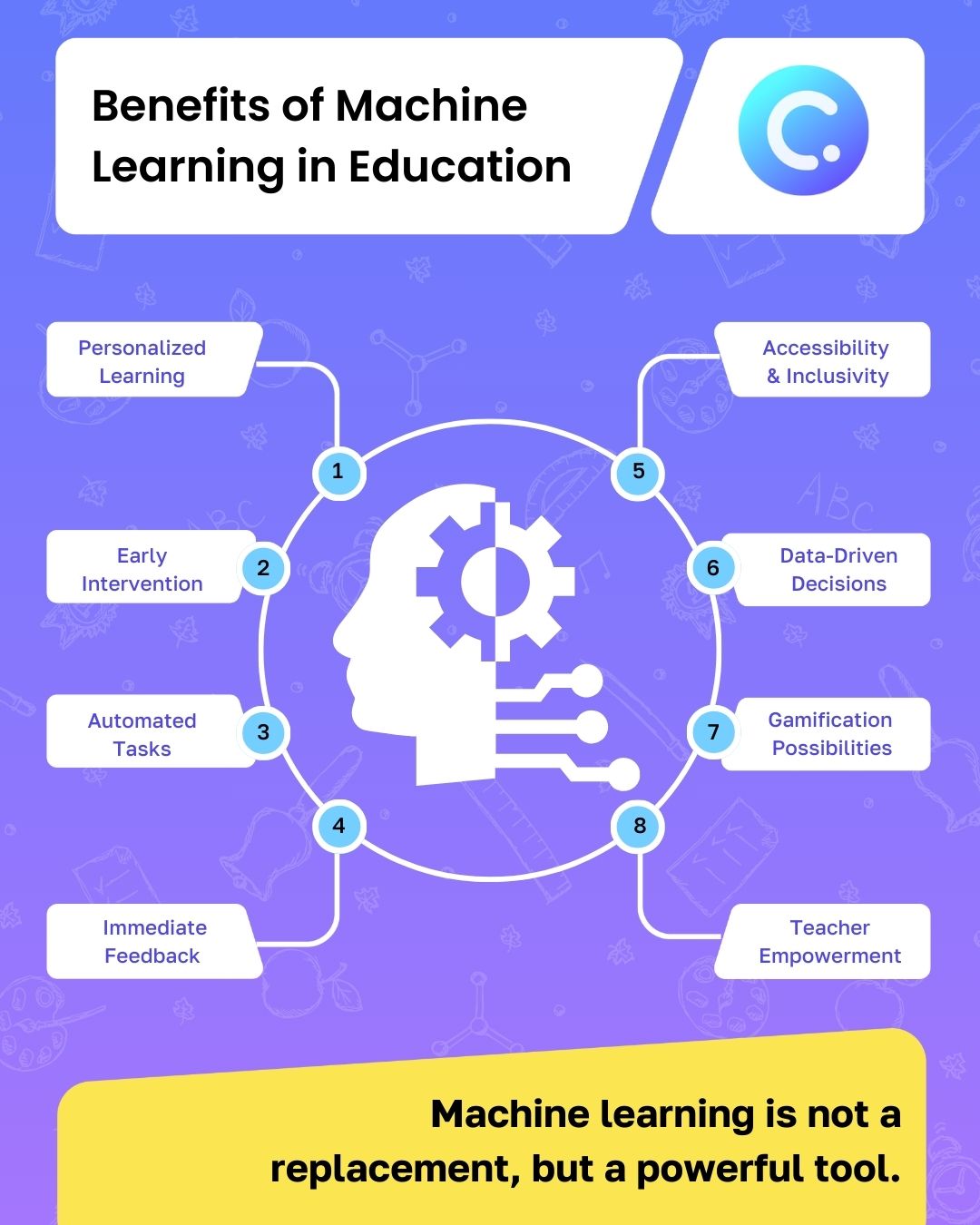
Machine learning doesn’t replace teachers. Instead, it acts as a supportive tool, providing educators with valuable data and insights to personalize learning for each student. It introduced the ability to create tailored learning plans, gamification strategies, and data-driven decision-making.
Here’s a closer look at some of the most impactful benefits of machine learning in education:
#1 Personalized Learning
Machine learning personalizes the learning experience by tailoring instruction and resources to individual student needs. For example, it can help identify a student struggling with a math lesson, allowing the teacher to send out extra practice problems that target their specific weaknesses. This individualized approach fosters a deeper understanding and keeps students engaged.
#2 Early Intervention & Support
Machine learning systems can analyze student data to identify those at risk of falling behind before their struggles become significant. This empowers educators to provide early intervention and targeted support, preventing students from experiencing frustration and discouragement.
#3 Enhanced Efficiency
Machine learning in education can automate time-consuming tasks like grading essays, freeing up valuable educator time for more personalized guidance. ML-powered feedback systems can also provide students with immediate insights into their performance, allowing them to identify areas for improvement on their own.
#4 Accessibility & Inclusivity
ML breaks down language barriers by translating learning materials and making education accessible to a wider range of students. Additionally, ML offers adaptive tools that cater to diverse learning styles and can assist students with disabilities.
These modern differentiated instruction strategies can help you meet the needs of all your students with ease.
#5 Data-Driven Insights for Improvement
Machine learning facilitates the collection and analysis of valuable data on student performance and learning patterns. This data provides educators with insights into areas where the curriculum or teaching methods can be improved, leading to better educational outcomes overall.
In essence, machine learning in education empowers teachers to personalize learning, identify struggling students early on, and create a more engaging and effective learning environment for all. This fosters a future of education where every student has the opportunity to thrive.
10 Brilliant Examples of Machine Learning in Education (with Actionable Tips and Apps)
Machine learning isn’t just a futuristic concept – it’s actively transforming classrooms today, and EdTech platforms are at the forefront of this revolution. These platforms leverage ML to address diverse educational challenges, offering innovative solutions that enhance student engagement, personalize learning pathways, and optimize teaching methodologies.
Here are 10 machine learning examples where it’s reshaping the educational landscape through EdTech platforms.
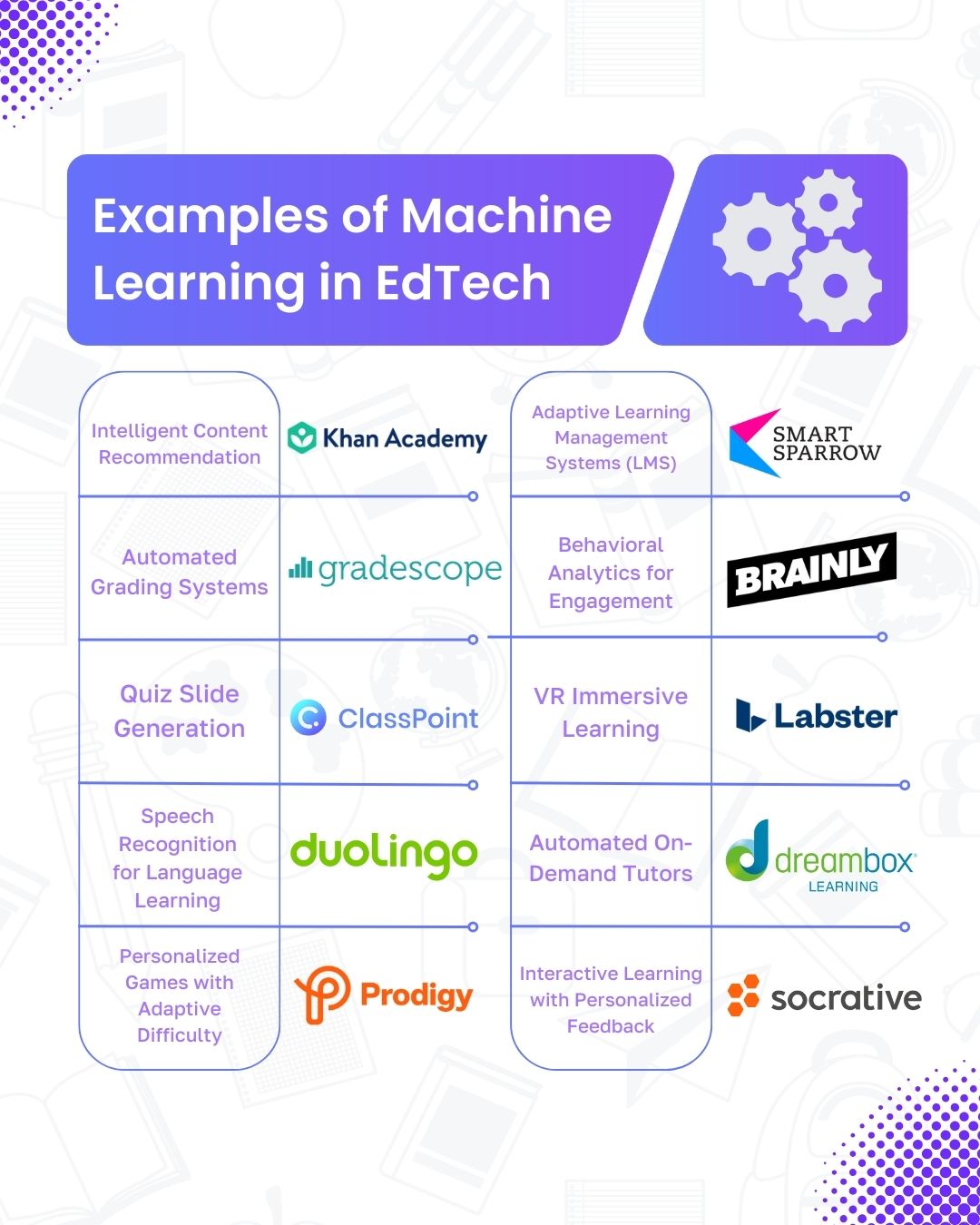
1. Intelligent Content Recommendation Systems
What is it?
Intelligent content recommendation systems use machine learning to analyze student behavior and learning preferences. This analysis allows the system to suggest relevant educational content, such as materials, videos, or resources, that align with individual student needs.
How it works
These systems track student interactions with learning materials and identify patterns in their preferences. For example, a student who consistently watches videos on a particular topic might be recommended similar videos or in-depth articles on that subject.
Recommended ML apps
How to Implement in the Classroom
- Use the suggested content recommendations as a starting point for personalized learning pathways.
- Encourage students to explore the recommended materials while monitoring their progress and interests.
2. Automated Grading Systems
What is it?
Automated grading systems powered by machine learning can scan student writing and multiple-choice responses. This analysis provides instant feedback on grammar, style, and comprehension, freeing up valuable educator time for more personalized interactions.
How it works
These systems use machine learning algorithms to identify patterns in correct and incorrect responses. They can inspect elements like grammar, sentence structure, and keyword usage in essays, and evaluate answer choices in multiple-choice questions.
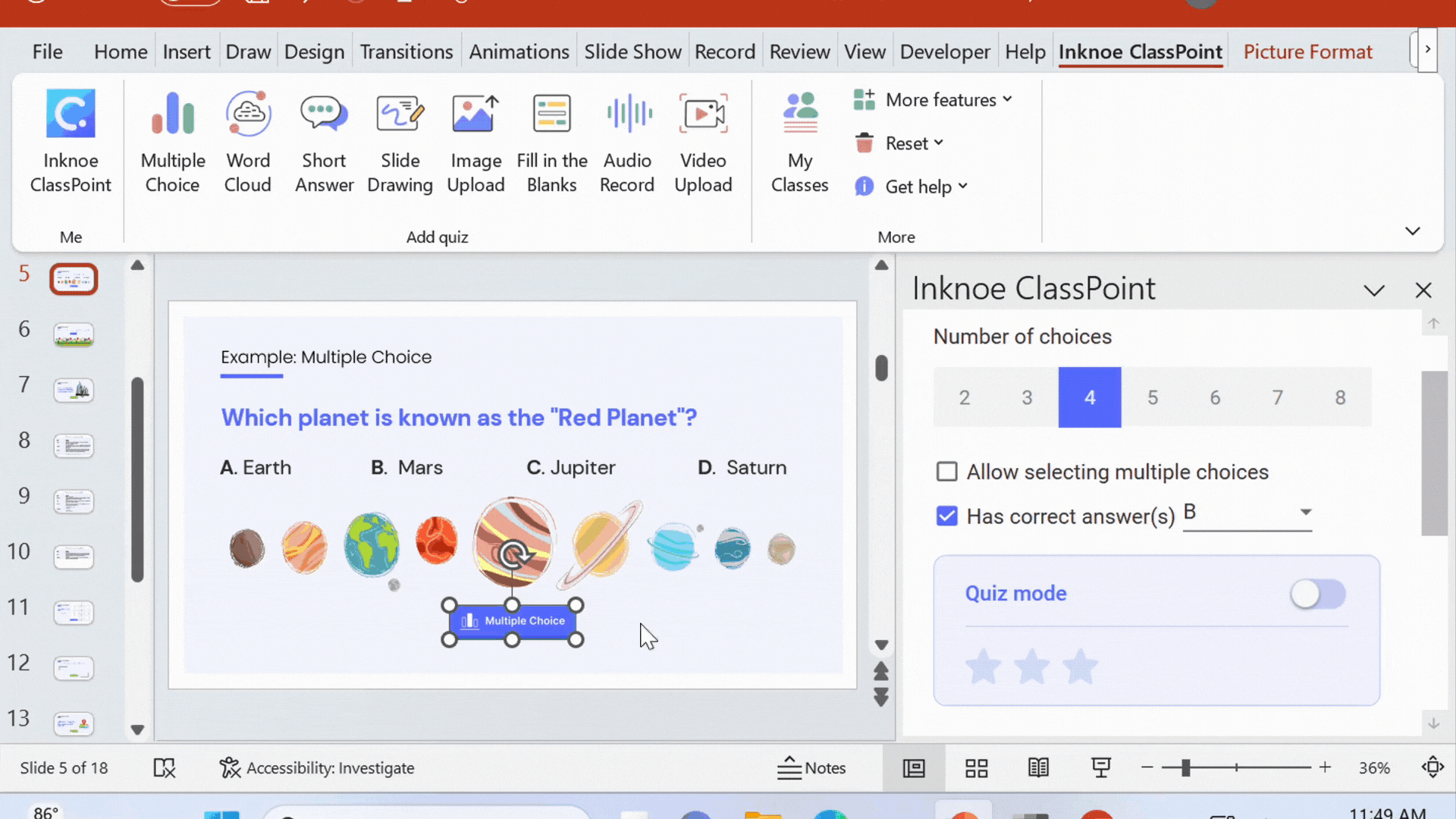
Recommended ML apps
How to Implement in the Classroom
- Make use of these automated grading systems for multiple-choice quizzes and short writing assignments.
- Leverage the data provided by automated graders to identify areas where students might need additional support.
Try these tips on how to set up automatic grading directly on your PowerPoint presentations for increased efficiency.
3. Quiz Slide Generation with Analytics
What is it?
There are tools that utilize machine learning and AI to automatically create quizzes based on your existing input, content or PowerPoint slides. This allows for a live interactive quiz experience where students can answer questions and interact with the teachers in real time.
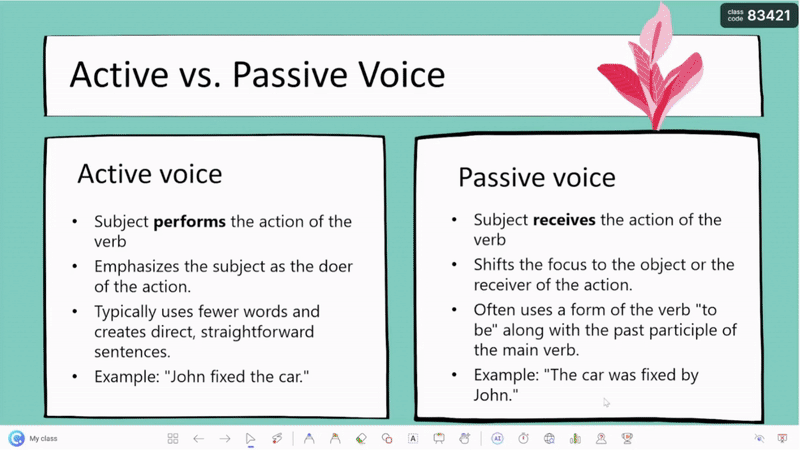
How it works
These platforms analyze the input or content within your slides and identify key concepts. The machine learning algorithms then generate quiz questions in various formats, ranging from multiple-choice, fill-in-the-blank, or short answer questions that assess student understanding of the presented material. Additionally, these platforms offer features like real-time student response tracking and analytics, allowing educators to gauge comprehension and adapt their teaching approach on the fly. What’s more, tools like ClassPoint AI even go the extra mile to generate questions based on Bloom’s Taxonomy levels, tailored towards educators’ need.
Recommended ML apps
How to Implement in the Classroom
- Integrate quizzing experience into your existing lessons or PowerPoint presentations for a more interactive learning experience.
- Real-time student response data can be used to identify areas where students might be struggling and adjust your teaching accordingly.
- The analytics provided by these platforms can track student progress and identify areas for improvement in future lessons.
4. Speech Recognition for Language Learning
What is it?
Language learning apps use machine learning algorithms to analyze pronunciation patterns in spoken language. This allows EdTech applications to provide personalized feedback and enhance language learning through an immersive experience.
How it works
These platforms use machine learning to compare a student’s spoken pronunciation with native speaker recordings. By identifying discrepancies, the system can offer personalized feedback on aspects like intonation, stress placement, and individual sounds. This immediate feedback helps learners adjust their pronunciation and improve their fluency.

Recommended ML apps
How to Implement in the Classroom
- Encourage students to make use of speech recognition features within language learning apps to receive personalized feedback on pronunciation.
- Supplement traditional language learning activities with exercises that focus on spoken communication.
- Consider incorporating pair or group activities where students can practice speaking and receive feedback from each other.

5. Personalized Learning Games with Adaptive Difficulty
What is it?
Personalized learning games implement machine learning to adjust the difficulty level of games based on student performance. This keeps students engaged and motivated by providing an appropriate challenge level.
How it works
These game-based learning platforms monitor student performance within the game and identify areas of strength and weakness. Machine learning algorithms then adjust the difficulty level by presenting more complex challenges to students who are excelling and offering additional hints or simplified versions of challenges for those who might be struggling.

Recommended ML apps
How to Implement in the Classroom
- Explore game-based learning platforms that offer adaptive difficulty features.
- Integrate these games into your curriculum as a supplement to traditional learning activities.
- Monitor student progress within the games and use the data to identify areas where additional support might be needed.
Further gamify your classroom with these PowerPoint templates inspired by American game shows like Jeopardy and Wheel of Fortune.
6. Adaptive Learning Management Systems (LMS)
What is it?
Adaptive Learning Management Systems (LMS) utilize machine learning to create personalized learning paths within the LMS platform. This ensures that students receive the most relevant materials and support based on their individual progress.
How it works
These LMS platforms use machine learning algorithms to examine student performance data, such as quiz results and assignment completion. Based on this data, the system tailors the learning experience by suggesting relevant resources, adjusting the difficulty level of assignments, and recommending additional practice exercises in areas where students might be struggling.

Recommended ML apps
How to Implement in the Classroom
- Monitor student progress through the personalized learning paths generated by the system.
- Use the data provided by the LMS to identify areas where students might need additional support or enrichment activities.
7. Behavioral Analytics for Student Engagement
What is it?
In this context, machine learning algorithms are used to examine user behavior within EdTech platforms. This data-driven approach helps educators identify areas where students might need additional support or modifications to the learning experience.
How it works
These applications track student interactions with learning materials and consider factors like time spent on tasks, completion rates, and response patterns. By identifying patterns in student behavior, the system can alert educators to potential areas of difficulty or disengagement.
Recommended ML apps
How to Implement in the Classroom
- Analyze the data provided by these platforms to identify students who might be struggling or disengaged.
- Use this information to tailor your teaching approach and provide targeted support to students who need it most.
8. Immersive Learning with Personalized VR Simulations
What is it?
VR simulations and machine learning work together to personalize virtual reality simulations for various subjects. This creates an engaging and interactive learning experience that caters to individual learning styles.
How it works
These platforms leverage machine learning to adapt the complexity of information presented within VR simulations based on a student’s understanding. For example, a student exploring the human body in VR might receive a more detailed explanation of a particular organ system if they show signs of struggling with that concept.

Recommended ML apps
How to Implement in the Classroom
- Explore the availability of VR learning experiences within your subject area.
- Ensure your classroom has the necessary VR equipment and compatible devices.
- Utilize VR simulations as a supplement to traditional learning activities and encourage student discussion and reflection after the experience.
9. Automated On-Demand Tutors
What is it?
Machine learning provides personalized support to students through automated, on-demand tutors. These intelligent tutoring systems analyze student responses and tailor instruction, offering real-time feedback and adapting to individual needs.
How it works
The machine learning algorithms help identify patterns in student responses and assess understanding. Based on this analysis, the system provides targeted feedback, hints, or suggests alternative approaches to solve problems. This allows students to receive immediate support and clarification on concepts they might be struggling with.
Recommended ML apps
How to Implement in the Classroom
- Integrate automated tutoring systems as a supplement to your classroom instruction.
- Encourage students to utilize these platforms for additional practice and personalized feedback.
- Use the data provided by the tutoring systems to identify areas where students might need further support from you.
10. Interactive Learning with Personalized Feedback
What is it?
Interactive learning with personalized feedback leverages machine learning to create a dynamic learning experience. These platforms analyze student responses to questions or tasks in real time, providing instant and personalized feedback.
How it works
Machine learning algorithms can analyze student responses to questions, quizzes, or activities. Based on this analysis, the system provides immediate feedback that highlights areas of strength, identifies misconceptions, and suggests corrective actions. This allows students to adjust their understanding and improve their performance on the spot.

Recommended ML apps
How to Implement in the Classroom
- Use these platforms for formative assessment to identify student understanding and adjust your teaching accordingly.
- Encourage student discussion and collaboration based on the feedback provided by the system.
As EdTech platforms continue to evolve and integrate sophisticated machine learning algorithms, we can expect even more innovative applications that personalize learning and empower all students to thrive in the digital age.
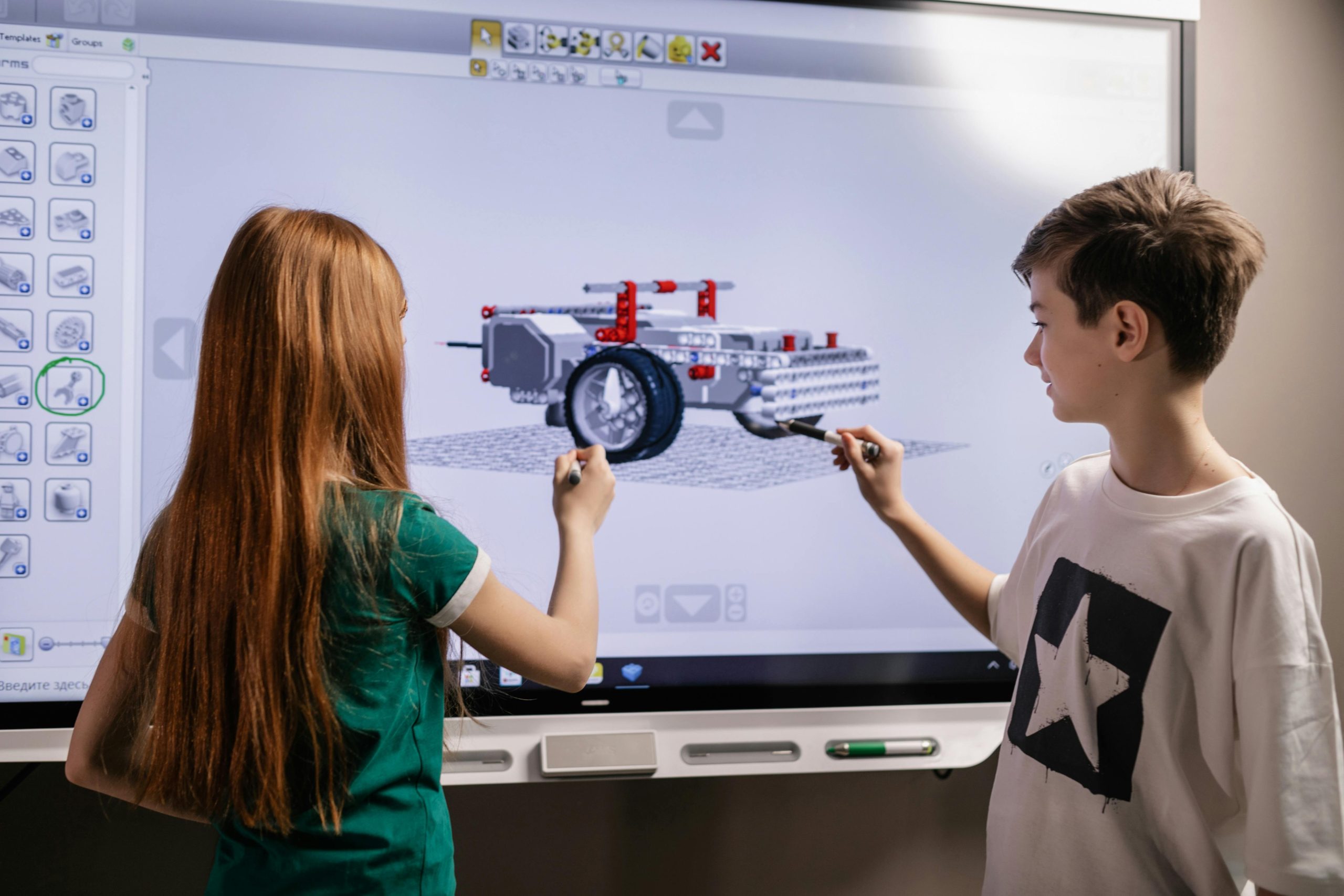
FAQs
What are the potential roadblocks when implementing machine learning in education?
While exciting, implementing machine learning in education requires careful consideration. Data quality and potential biases can lead to inaccurate results. Teacher training is crucial to effectively use these tools and interpret data. Privacy concerns necessitate robust security measures and clear communication. Finally, ensuring equitable access to technology is essential for all students to benefit.
How can educators ensure that machine learning is used ethically in the classroom?
Educators can ensure ethical use by prioritizing student privacy, staying informed about machine learning applications, advocating for transparent algorithms, and fostering open communication with students, parents, and school administrations. Ethical guidelines and ongoing professional development are essential components.
Can machine learning replace traditional teaching methods?
Machine learning complements traditional teaching methods by introducing adaptability and personalization. It enhances, rather than replaces, teaching by providing tools for more effective, student-centric education.
What are the future trends for machine learning in education?
The future of AI in education with machine learning is brimming with innovation. Expect to see AI tutors adapting to a student’s learning style and even emotional state in real time, creating a hyper-personalized learning experience. Machine learning will also transform assessment, going beyond simple answer checks to analyze student work for deeper understanding and providing targeted feedback for improvement.
Final Thoughts
Machine learning is actively shaping the learning landscape today. While the possibilities are vast, it’s important to remember that ML isn’t a magic solution. Rather, it’s a powerful tool that works best when educators and technologists work together. Educators remain the guiding force, empowered by machine learning to personalize learning, identify student needs, and create a dynamic learning environment.
With machine learning in education, the future is already here. As this technology continues to evolve, we can expect even more transformative applications. Leveraging ML requires continuous cooperation between educators, technologists, and students to ensure that machine learning empowers a more personalized and effective learning experience for all.
